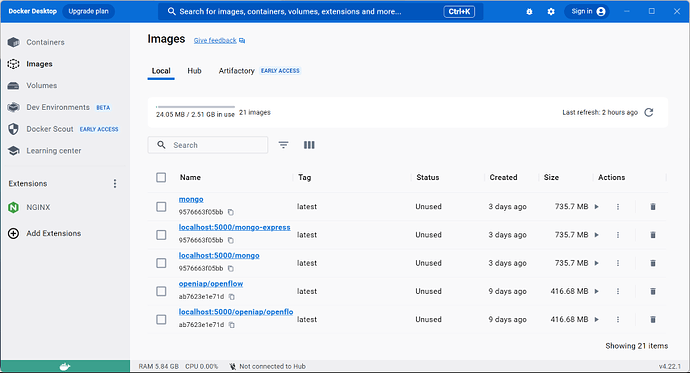OpenRPA version: 1.4.54
OpenFlow version: 1.5.0
Using app.openiap.io or self hosted openflow: self hosted Docker Desktop
Error message: On screen - error message is
(HTTP code 404) no such container - No such image: openiap/noderedagent:latest
Screenshot or video:
Attach a simple workflow from OpenRPA or NodeRED that reproduces the error/issue:
This is a follow on at Allan’s request to Nodered Agent not working, which I had posted on as this issue for me was (I thought) purely about NodeRED.
I am a citizen developer - apart from doing the no-code bit, (I can point and click and use parameters to a degree), I can use the cmd prompt a little bit, some baby steps in Python, but little to zero knowledge in networking, and useless at scripting and coding.
Here is what I have done sofar to try to get OpenRPA/OpenFlow/NodeRED installed on the same desktop, without using any cloud services, just with github and git.
- Downloaded OpenRPA. Installed and played around with it. Cleared out Docker Desktop and ran it as admin.
- Read the url - GitHub - open-rpa/docker . Installed git, cloned that latest repository at the url quoted above. cd to the docker subfolder. Ran normal-up.bat.
- Disconnected my internet access to make sure I was not getting anything from your server, just what I had on my computer.
- tried localhost - got a 404. tried localhost.openiap.io - got localhost.openiap.io ’s server IP address could not be found. tried localhost.openiap.io/#/main - got localhost.openiap.io ’s server IP address could not be found.
- Installed nginx on Docker Desktop to make sure the server functioned, to test the Docker installation. It worked fine.
- Watched the video referred to on the web page referenced above.
- The web page did not give me the guidance I was seeking about how to integrate NodeRED into the installation.
- The video focussed on topics other than how to install on a single machine.
I have read the instructions on the url noted above. These have no information regarding NodeRED. I have watched the video referred to in the url. That is for people in a different situation. My objective is to use an OON setup in Docker where the installation is done just from files on github (no assistance from your servers), and have that installation coexist/play nicely with other server software that I also host on Docker.
It does seem as though it really is quite simple for people who know what they are doing.
My request is that you or some other kind person can give us citizen developers a monkey see monkey do guide/set of instructions in a list so if someone follows it they will produce the result. Or perhaps even bundle up everything in a Docker image that can be downloaded from your website.
My hunch is that the help needed is in 2 main areas - one is the network and ports info so that the DD installation is viewable, and secondly showing us exactly how to integrate NodeRED in its new position as an agent - the url to get the code from and instructions.
I hope that providing a guide will help many more people than just myself. Maybe Anders could help ? In the meantime I attach a few screenshots of where my installation is at.
Regards





